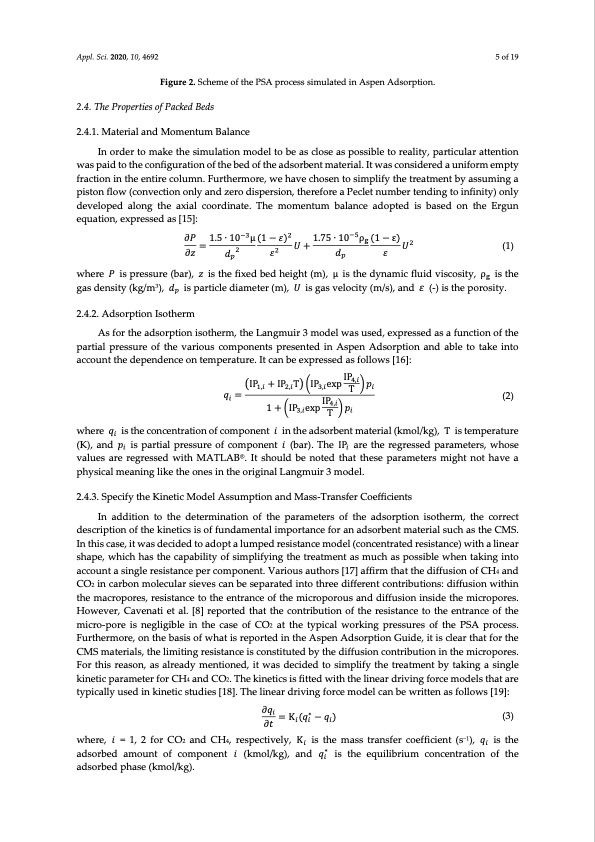
PDF Publication Title:
Text from PDF Page: 006
Appl. Sci. 2020, 10, 4692 5 of 19 Figure 2. Scheme of the PSA process simulated in Aspen Adsorption. 2.4. The Properties of Packed Beds 2.4.1. Material and Momentum Balance In order to make the simulation model to be as close as possible to reality, particular attention was paid to the configuration of the bed of the adsorbent material. It was considered a uniform empty fraction in the entire column. Furthermore, we have chosen to simplify the treatment by assuming a piston flow (convection only and zero dispersion, therefore a Peclet number tending to infinity) only developed along the axial coordinate. The momentum balance adopted is based on the Ergun equation, expressed as [15]: ∂𝑃 1.5∙10μ(1−𝜀) 1.75∙10ρ (1−ε) ∂𝑧=𝑑 𝜀𝑈+𝑑 𝜀𝑈 (1) where 𝑃 is pressure (bar), 𝑧 is the fixed bed height (m), μ is the dynamic fluid viscosity, ρ is the gas density (kg/m3), 𝑑 is particle diameter (m), 𝑈 is gas velocity (m/s), and 𝜀 (-) is the porosity. 2.4.2. Adsorption Isotherm As for the adsorption isotherm, the Langmuir 3 model was used, expressed as a function of the partial pressure of the various components presented in Aspen Adsorption and able to take into account the dependence on temperature. It can be expressed as follows [16]: IP, +IP,TIP,expIP,𝑝 𝑞 = T (2) 1 + IP, exp IP, 𝑝 T where 𝑞 is the concentration of component 𝑖 in the adsorbent material (kmol/kg), T is temperature (K), and 𝑝 is partial pressure of component 𝑖 (bar). The IP are the regressed parameters, whose values are regressed with MATLAB®. It should be noted that these parameters might not have a physical meaning like the ones in the original Langmuir 3 model. 2.4.3. Specify the Kinetic Model Assumption and Mass-Transfer Coefficients In addition to the determination of the parameters of the adsorption isotherm, the correct description of the kinetics is of fundamental importance for an adsorbent material such as the CMS. In this case, it was decided to adopt a lumped resistance model (concentrated resistance) with a linear shape, which has the capability of simplifying the treatment as much as possible when taking into account a single resistance per component. Various authors [17] affirm that the diffusion of CH4 and CO2 in carbon molecular sieves can be separated into three different contributions: diffusion within the macropores, resistance to the entrance of the microporous and diffusion inside the micropores. However, Cavenati et al. [8] reported that the contribution of the resistance to the entrance of the micro-pore is negligible in the case of CO2 at the typical working pressures of the PSA process. Furthermore, on the basis of what is reported in the Aspen Adsorption Guide, it is clear that for the CMS materials, the limiting resistance is constituted by the diffusion contribution in the micropores. For this reason, as already mentioned, it was decided to simplify the treatment by taking a single kinetic parameter for CH4 and CO2. The kinetics is fitted with the linear driving force models that are typically used in kinetic studies [18]. The linear driving force model can be written as follows [19]: ∂𝑞 = K(𝑞∗ − 𝑞) (3) ∂𝑡 where, 𝑖 = 1, 2 for CO2 and CH4, respectively, K is the mass transfer coefficient (s−1), 𝑞 is the adsorbed amount of component 𝑖 (kmol/kg), and 𝑞∗ is the equilibrium concentration of the adsorbed phase (kmol/kg).PDF Image | Biogas Six-Step Pressure Swing Adsorption

PDF Search Title:
Biogas Six-Step Pressure Swing AdsorptionOriginal File Name Searched:
applsci-10-04692.pdfDIY PDF Search: Google It | Yahoo | Bing
CO2 Organic Rankine Cycle Experimenter Platform The supercritical CO2 phase change system is both a heat pump and organic rankine cycle which can be used for those purposes and as a supercritical extractor for advanced subcritical and supercritical extraction technology. Uses include producing nanoparticles, precious metal CO2 extraction, lithium battery recycling, and other applications... More Info
Heat Pumps CO2 ORC Heat Pump System Platform More Info
| CONTACT TEL: 608-238-6001 Email: greg@infinityturbine.com | RSS | AMP |